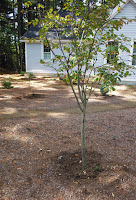Last evening was uncommonly warm
for late December. Moreover, it was
raining. The confluence of those two
meteorological events caused Betty and me to get in our car and head for West
Boylston, Massachusetts, to see the 19th annual installment of
‘Winter Reimagined’ at the Tower Hill Botanic Garden.
Getting people to visit a
botanical garden in winter is a marketer’s challenge. The New York Botanical Garden hosts a
‘Holiday Train Show’ in its Conservatory.
The Massachusetts Horticultural Society has a Festival of Trees. The Worcester County Horticultural Society,
which is more or less synonymous with Tower Hill, has come up with a stunning
and original alternative: a festival of lights outdoors, and a fairy land of
whimsical trees and more lights indoors. These blog pieces customarily include captions with all photos. In this case, they seem superfluous. I encourage you to double-click on any image to see a full-screen slideshow.
The outdoor component is worth a
trip all by itself. The formal gardens
around the Tower Hill campus are decked out in lights; each tree and hardscape
structure a different color. The effect
is stunning and the view dramatically changes as you walk within individual
gardens. Even the ground covers are
strung with lights. A lot of thought and
considerable imagination has gone into creating vistas that cry out for you to
stop to admire and try your hand at nighttime photography.
It’s the indoor part, though,
that pulls out all the stops. Tower Hill
starts with two exceptional assets: a pair of gorgeous conservatories, the
Orangerie and the Limonaia. Both are
filled with mature subtropical plants that are an antidote to a New England
winter. For Winter Reimagined, there are
lights. Not overpowering and not
intrusive. The lights are subtle tweaks
that turn an already handsome pair of spaces into something that is, well,
romantic.
The other indoor spaces within Tower
Hill are given over to decorated trees and something very special and unusual:
an igloo.
First, the trees. You’re probably thinking, “another Festival
of Trees”. You’re wrong. Yes, these are artificial Christmas trees
and, yes, they’re decorated. But that’s
where the similarity ends. These trees
are decked out to be in sync with nature.
The materials on many of the trees are pine cones, seed pods, nuts and
such. For others, the theme is
recycling: everything on the tree is re-purposed from everyday disposable
objects. Think flowers from soda
bottles, for example. A tree sponsored
by one of Tower Hill’s caterers has a ‘topper’ of gold-sprayed forks and knives
gloriously exploding out of a Styrofoam ball.
You can’t win these trees in a
raffle or buy them from Tower Hill; they’re there to admire and to
inspire. Many are the creation of the
Tower Hill staff and volunteers. Some
trees are more memorable than others, but the overall effect is spectacular.
Then, there’s the igloo. In a space beyond the Orangerie is a modest
room and, in the room is a large reindeer, some trees sprayed white, and a
luminescent igloo. It’s maybe four feet
high and eight feet wide and will comfortably seat three or four children. It’s made out of (pause for dramatic effect)…
plastic milk jugs. Several hundred
gallon-sized containers that would have otherwise had a single two-week
existence as a holder of milk or less wholesome beverage have been re-purposed
to create a fun environment. It’s a kid
magnet and I hope the adults chaperoning those children take the opportunity to
speak to their charges about the wonders of recycling.
There’s no Santa at Winter
Reimagined. This is a non-sectarian celebration
that aims to lift everyone’s spirits on the shortest days and longest nights of
the year. The event runs through January
3rd. It is free to Tower Hill
members. Non-member adults pay $15,
seniors are $10, children 6-18 are $5 and those younger are free.














































